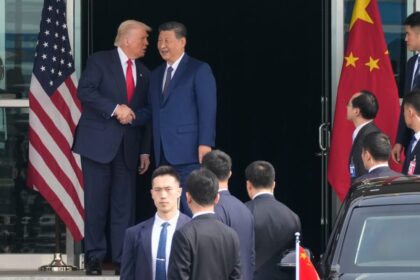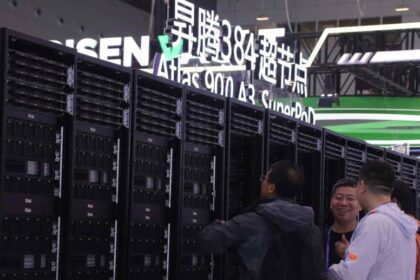Africa’s consumer wave draws a new kind of Chinese investment
A new phase of China and Africa commerce is taking shape. After two decades marked by large railways, power plants, mines, and oil deals led by state owned enterprises, momentum is shifting toward private companies and everyday products. From phones and fridges to solar kits and medical supplies, Chinese brands are chasing Africa’s growing consumer class. The fastest growing African economies, including Kenya, Uganda, and Zambia, are drawing more company leaders who want to test products on the ground and map out partnerships with local distributors and retailers.
- Africa’s consumer wave draws a new kind of Chinese investment
- Why the old model of projects and mines is giving way
- What is selling in Africa’s cities
- Local production and regional value chains take shape
- The currency question and how deals get paid
- Risks for local industry and what policymakers are watching
- Infrastructure is not gone, just refocused
- What to Know
Investment patterns tell the story. Since 2015, Chinese investments tied to Africa’s resource sectors have fallen by around 40 percent as returns weakened and commodity earnings slid. At the same time, official trade data show a sharp jump in Chinese exports to Africa, including a 28 percent rise year over year in the first three quarters of 2025. Most of those goods are higher value manufactured products such as electronics, plastics, textiles, home appliances, and machinery. Premier Li Qiang’s participation at a recent G20 gathering in South Africa underscored that senior political engagement continues even as corporate strategies evolve. Flagship brands such as Transsion, Huawei, and Midea are deepening their presence, while thousands of smaller entrepreneurs are pushing into e-commerce, dropshipping, and physical retail.
The pull is structural. Profit margins at home are tighter for many Chinese firms, and tariff walls in the United States and parts of Europe make Africa’s young, urban, and digitally connected population a compelling bet. Household spending on the continent is projected to exceed 2 trillion dollars by 2030, and the African Continental Free Trade Area (AfCFTA) promises to knit 54 economies into a more integrated market. Logistics are improving, smartphone adoption keeps rising, and social media shortens the distance between a warehouse in Guangzhou and a shop counter in Accra or Nairobi. The result is a race to capture everyday demand, from budget smartphones and fashion to power solutions and kitchen appliances.
Why the old model of projects and mines is giving way
The retreat from mega projects and minerals is rooted in economics and policy. The early years of the Belt and Road Initiative directed vast financing toward transport, ports, power, and extraction. As growth slowed and debt risks rose, Chinese lenders pulled back. New loan commitments to African governments dropped from tens of billions of dollars in 2016 to below 1 billion dollars by 2022, according to international datasets. Analysts also point to the shift inside China from investment led growth toward more balanced consumption, which reduces appetite for raw materials and shifts the export mix toward manufactured goods and services. China remains a key creditor for many African countries and a crucial trade partner, but the tools of engagement are changing, with less sovereign lending and more trade credit, equity, and private investment.
Energy demand patterns matter too. China is buying less crude oil from Africa as it deploys electric vehicles and clean energy at home, a trend that weakens the case for new oil field ventures on the continent. Economists estimate that a 1 percentage point slowdown in China’s growth tends to shave a quarter point off sub Saharan Africa’s growth within a year, a reminder that commodity cycles and Chinese policy shifts ripple across the region. Those linkages are pushing governments and companies to look beyond resource extraction toward producing, shipping, and selling goods that African consumers want.
From loans to trade and private capital
Private firms are now the main engine of China’s commercial footprint in Africa. Surveys suggest more than 70 percent of Chinese enterprises operating on the continent are privately owned. Outward direct investment from China rose in 2024, including over 30 billion dollars to Belt and Road partner markets, while overseas mergers and acquisitions in Africa increased even as dealmaking in the United States hit a decade low. Engineering and construction activity has not vanished, but it is evolving toward greener, more efficient projects and digital infrastructure. The mix of equity stakes, trade financing, local partnerships, and smaller scale manufacturing plants points to a more decentralized, market driven approach than the big ticket, state financed model of the 2010s.
What is selling in Africa’s cities
Reliable power can be costly or inconsistent in many markets, which is why solar panels, inverters, and battery kits feature prominently in shipping manifests. Medical supplies and diagnostics are in demand across public clinics and private pharmacies. Household goods such as fans, refrigerators, small kitchen appliances, and affordable furniture are filling new apartment blocks in fast growing suburbs. In mobile phones, Chinese firms have crafted a durable position by blending price with features tailored to local tastes, such as strong battery life, bright screens, and camera software tuned for low light conditions. Accessories, fashion, and personal care products round out a long tail of daily purchases.
Large manufacturers are pairing exports with local assembly and distribution. Midea, the appliance maker, has invested in factories in Egypt to serve North Africa and the wider region and has signaled plans for more capacity. That mix of local production, regional hubs, and last mile delivery networks reflects a simple reality. Price and proximity matter. Companies that shorten delivery times and offer reliable after sales service gain an edge with consumers who compare value across brick and mortar stores and e-commerce apps.
There is also a retail push that puts curated Chinese brands in front of shoppers. In Nairobi, a new Yiwu Selection store brings a slice of China’s vast consumer goods ecosystem to Kenya’s capital. The outlet stocks more than 20 brands from Yiwu, the manufacturing and trade city in Zhejiang Province, with goods that range from household items and digital accessories to cosmetics, beachwear, and fashion jewelry. The concept aims to match quality, variety, and price with the preferences of women aged 25 to 55, and to offer dependable sourcing for local retailers.
At the Nairobi launch, Shao Chunhong, vice mayor of Yiwu, explained why the brand collection model fits current demand.
Yiwu products are well suited to the African market.
Kenyan officials see room for deeper production partnerships alongside retail. Olivia Rachier, general manager for Legal and Corporate Affairs at the Kenya Investment Authority, welcomed the new store and set a broader tone.
Kenya welcomes Chinese investment across a wide range of sectors.
Executives behind the store say partnerships with local malls and franchise arrangements with Kenyan retailers are on the table, part of a wider push to create predictable channels for popular Chinese consumer brands.
Local production and regional value chains take shape
Africa’s leaders do not want the continent to import everything it consumes. One of the clearest signs of change is the growth of local manufacturing owned or supplied by Chinese companies. Sunda International, for example, has built more than 20 production centers in multiple African countries and focuses on necessity markets. Industry figures say the company generates hundreds of millions of dollars in annual revenue by producing goods that people buy every day. Local plants like these create jobs, reduce shipping costs and delays, and help stabilize prices in markets where logistics can be unpredictable.
AfCFTA and the need to build within Africa
The AfCFTA, launched in 2021, is designed to create a continent wide single market with a projected 1.7 billion people and 6.7 trillion dollars in combined spending by 2030. The agreement reduces tariffs and targets non tariff barriers that have long fragmented trade. It also encourages common standards and smoother customs, which helps companies move goods between neighbors. Analysts argue that this framework can unlock a new wave of investment in manufacturing and integration into regional supply chains if it is paired with better transport links and power. Coordination between AfCFTA priorities and cross border infrastructure plans can boost the odds that factories and logistics hubs succeed.
Local production also helps firms manage currency and policy risks. As companies like Midea build in Egypt to serve nearby markets, they cut freight times, limit exposure to exchange swings, and learn local preferences faster. For governments, policies that encourage assembly and supplier development, while protecting space for competitive local firms, can tilt the balance from pure import dependence toward jobs and skills at home. North Africa’s industrial clusters show how steady power, ports, and training programs can attract appliance, electronics, and automotive makers that sell into Africa’s growing cities.
The currency question and how deals get paid
Trade settlement shapes who gains and who takes the risk. Use of the Chinese yuan in Africa is growing from a low base, but the United States dollar still dominates, especially where trade is unbalanced in China’s favor. Some African governments and lenders have tested alternatives, including issuing Panda bonds in China’s market. Payment systems are also improving. Banks and fintechs are building cross border rails that reduce transaction costs, and mobile money remains a daily lifeline for consumers and small merchants in many countries. Even with these advances, most large shipments and equipment contracts still settle in dollars, which is one reason why countries track trade deficits closely when imports surge.
Risks for local industry and what policymakers are watching
Cheap imports help families stretch budgets and can keep inflation in check, yet they also put pressure on local factories that struggle to match China’s scale and supply chains. Trade deficits can widen as consumer goods flood the market. Finance is changing too. Chinese policy bank lending to African governments has slowed, and debt service now absorbs a larger share of budgets in some countries. Independent research groups expect Chinese finance to remain more selective, with steady but modest direct investment and a greater role for private capital.
Practical steps many are considering
Across the region, governments and businesses are steering toward a middle course that keeps consumer prices affordable while building productive capacity. The focus includes trade rules, investment promotion, and stronger ecosystems for local firms.
- Use AfCFTA safeguards and standards to manage surges in sensitive imports while tackling non tariff barriers that raise costs for local producers.
- Expand special economic zones and industrial parks linked to ports and rail so suppliers can cluster and share services.
- Negotiate local content and skills programs in major investments to grow supplier networks around anchor plants.
- Support small manufacturers with reliable power connections, logistics solutions, and access to finance.
- Streamline customs and improve cross border payments so regional trade in inputs and finished goods moves faster.
- Invest in technical training so workers can staff modern factories and service networks for appliances, electronics, and machinery.
Infrastructure is not gone, just refocused
Railways, ports, and power are still part of the story because they lower the cost of moving goods that consumers buy. A recent 1.4 billion dollar agreement to modernize a railway in Zambia signals continued cooperation where projects unlock trade corridors. Better freight links from inland cities to ports can shave days off delivery times for everything from phones to washing machines. That makes the consumer play more viable and spreads the gains beyond a single city or country.
Green and digital infrastructure is rising on agendas. Chinese and African partners have added more than 1.5 gigawatts of photovoltaic capacity in recent years, and companies are building data centers and applying 5G to manage traffic and utilities in several cities. Overseas engineering contracts remain large, with growing orders tied to energy efficient projects. That reinforces a pattern. Big construction is no longer the center of China’s Africa story, but it still supports the consumer shift by keeping goods, power, and data flowing.
What to Know
- The center of gravity in China Africa commerce is moving from state led mega projects and resources toward private sector consumer goods and services.
- Chinese investments in Africa’s resource sectors are down about 40 percent since 2015, while exports of manufactured goods to Africa rose sharply in 2025.
- Brands are targeting rising urban demand for phones, solar kits, medical supplies, and household appliances, with e-commerce and social media speeding market entry.
- Local manufacturing by Chinese firms is expanding, with companies such as Midea in Egypt and Sunda International across multiple countries producing for regional markets.
- The AfCFTA aims to create a single African market by 2030, which could boost regional value chains if paired with better logistics and power.
- Use of the yuan in trade is growing but limited; most large deals still settle in dollars, and trade imbalances persist in many countries.
- Cheap imports help consumers but strain local factories and can widen deficits; governments are balancing openness with measures to build domestic industry.
- Chinese finance is more selective than in the 2010s, with fewer big sovereign loans and more private capital, trade credit, and greener projects.
- Infrastructure has not disappeared. Rail, ports, data centers, and solar plants are still being built to support trade and a more connected consumer economy.
- Household spending in Africa is set to top 2 trillion dollars by 2030, keeping the continent central to Chinese consumer brand strategies.












